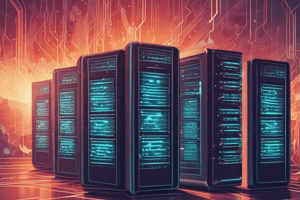Podcast
Questions and Answers
What is one of the primary differences between spreadsheets and databases?
What is one of the primary differences between spreadsheets and databases?
- The type of user interface
- How much data can be stored (correct)
- The level of data manipulation
- The type of data they can store
What is a characteristic of flat file databases?
What is a characteristic of flat file databases?
- They can contain multiple tables and relations
- They use Structured Query Language (SQL)
- They are highly flexible and scalable
- They use a simple structure with delimiters (correct)
What is the purpose of Structured Query Language (SQL)?
What is the purpose of Structured Query Language (SQL)?
- To provide an easy programming interface for database interaction (correct)
- To provide a user interface for databases
- To define the structure of a relational database
- To manage user access to a database
What is a characteristic of relational databases?
What is a characteristic of relational databases?
What is an example of a mini-world entity in a UNIVERSITY environment?
What is an example of a mini-world entity in a UNIVERSITY environment?
What is a relationship between SECTIONs and COURSEs in a UNIVERSITY environment?
What is a relationship between SECTIONs and COURSEs in a UNIVERSITY environment?
What is a characteristic of databases that allows multiple users to access and query data?
What is a characteristic of databases that allows multiple users to access and query data?
What is the primary difference between a flat file database and a relational database?
What is the primary difference between a flat file database and a relational database?
What is an example of a relationship between COURSEs and DEPARTMENTs in a UNIVERSITY environment?
What is an example of a relationship between COURSEs and DEPARTMENTs in a UNIVERSITY environment?
What is a characteristic of spreadsheets that makes them suitable for a single user or small number of users?
What is a characteristic of spreadsheets that makes them suitable for a single user or small number of users?
Flashcards are hidden until you start studying
Study Notes
Database Fundamentals
- A database is a collection of related data that is systematically organized to facilitate easy access, retrieval, management, and updates.
- A database can be thought of as a library that houses a wide range of books from different genres, where data is organized in rows and columns in the form of tables.
- Indexing the data makes it easy to find and retrieve it as and when required.
Types of Databases and Applications
- Traditional applications include numeric and textual databases.
- More recent applications include multimedia databases, geographic information systems (GIS), data warehouses, real-time and active databases, and many others.
Data and Database Management Systems (DBMS)
- Data refers to the information that is gathered, stored, accessed, and processed by a DBMS.
- A DBMS is a software package or system that facilitates the creation and maintenance of a computerized database.
- A DBMS facilitates the processes of defining, constructing, manipulating, and sharing databases among various users and applications.
Database Properties
- A database represents some aspect of the real world, sometimes called the mini-world.
- Changes to the mini-world are reflected in the database.
- A database is a logically coherent collection of data with some inherent meaning.
- A database is designed, built, and populated with data for a specific purpose.
Comparison with Spreadsheets
- Spreadsheets were originally designed for a single user or a small number of users who don’t need to do a lot of complex data manipulation.
- Databases, on the other hand, are designed to hold much larger collections of organized information and allow multiple users to quickly and securely access and query the data using complex logic and language.
Evolution of Databases
- The database started with a file-based system about 50 years ago and has gone through generations of evolution.
- The first database was introduced in 1968 as a flat-file-based database, followed by the hierarchical database, network data model, and relational database.
Hardware and Software
- Hardware includes physical electronic devices such as storage devices, I/O devices, and many more.
- Software refers to programs for managing and controlling the overall database, including the DBMS itself.
- The primary differences between hardware and software are how the data is stored and manipulated, who can access the data, and how much data can be stored.
Mini-World and Entities
- A mini-world refers to some part of the real world about which data is stored in a database.
- In the context of a university, some mini-world entities include students, courses, sections, departments, and instructors.
- Some mini-world relationships include sections being part of specific courses, students taking sections, courses having prerequisite courses, instructors teaching sections, and courses being offered by departments.
Studying That Suits You
Use AI to generate personalized quizzes and flashcards to suit your learning preferences.




